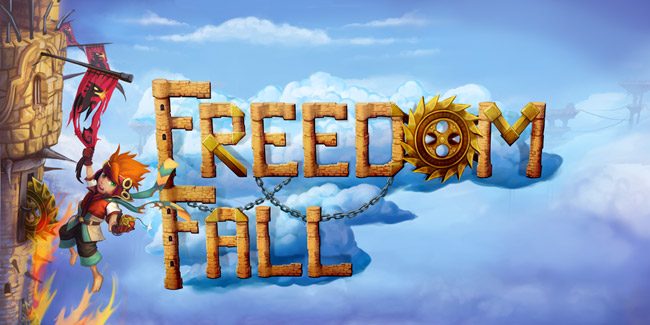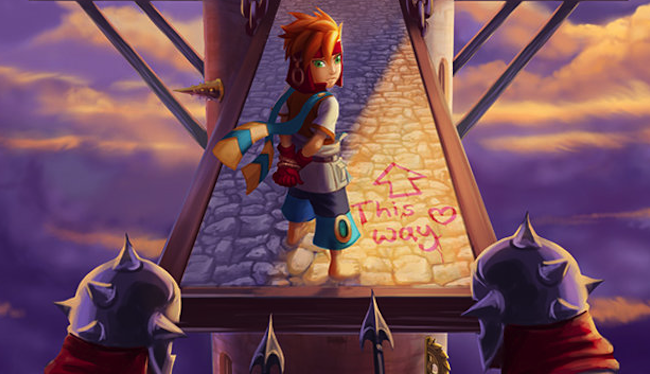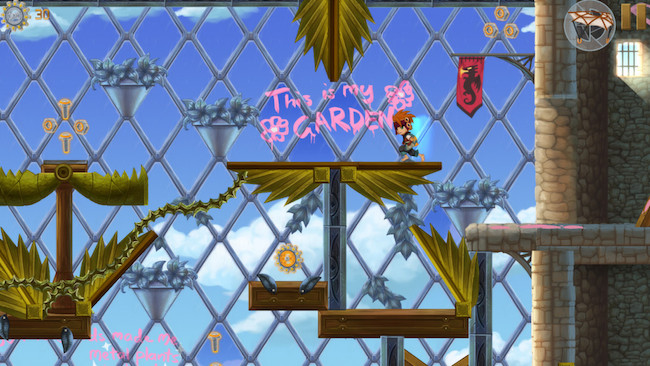
Earlier last year, we had the opportunity to review Freedom Fall at a time when the idea of a Steam Launch was still so far away. Having achieved this goal, we decided to deliver a fresh perspective!
I’ve loved platform games since day dot. My earliest gaming memory consists of my uncle bringing around a Nintendo Entertainment System with the Duck Hunt/Super Mario Bros. cartridge, and experiencing the stout, eponymous plumber’s first foray into home console adventures. I’ve always believed that the 2D platformer genre was one of the most important genres in gaming, and even now, decades on, there’s still room to create a fresh experience that doesn’t feel the need to pay homage to the roots of the genre. For this reason, I was all too happy when the Editor-In-Chief fired a release key my way, because soon I was navigating the architectural anomaly that comprised the tower of Freedom Fall. After having played the public demo at the Indie Day, and hearing first-hand the trials of the Stirfire crew in bringing this title to Steam, I feel a sense of jubilation in seeing their creation flourish on what’s arguably become the biggest platform for digital distribution in the last ten years.
In the beginning, there is practically no exposition, no cut-scene, or paragraphs of text. You’re at the top of the tower, in what appears to be a jail cell, and the only way to go is down. I think it’s important to note that I played Freedom Fall using a wired Xbox 360 controller because the game feels as if it was designed with a traditional controller in mind; which proved to be very responsive during my playthrough. I remember after meeting with the developers that one of my thoughts was that the controls felt a little “floaty” in the beta version, so it is great to say that the Stirfire crew have listened to this feedback; the controls now feel appropriately tightened and responsive. However, moving forward, I have included my own personal impressions for the Steam Release below!

The team at Stirfire took a rather unconventional approach with the narrative, which in turn, proved to be a real breath of fresh air in the scheme of interactive storytelling. As a first-time player, you aren’t initially given much to work with, apart from a title screen, and a starting screen atop an ominous tower. However, the ingenuity comes from the diegetic method of storytelling. Generally in gaming, there’s an unspoken rule of “environmental storytelling”, whereby the mere presence of world assets express the story of the world and unfolding events; irrelevant of the presence of exposition. For instance, in the classic DOOM games, you are aware of the catastrophe in the Phobos Base by the presence of zombified humans, hell-spawn, and demonic imagery. There is virtually no exposition in DOOM aside from the world unfolding as you traverse it. In contrast to environmental storytelling, “expository storytelling” is the up-front explanation of the plot the game takes place in, the world, the characters, the conflict etc. This is achieved via paragraphs of text, character dialogue, or an opening cut-scene.
In a more dynamic sense, environmental storytelling also applies to online gaming where player actions can leave a tangible “mark” on the world. One such example would be in the Counter-Strike series, where traversing a part of the map that displays bullet holes, blood spatters and dead bodies (of either allies or enemies) gives a clue that this was either an ambush, a choke-point, or the site of a mad scramble for the objective. Such environmental storytelling aids in explaining the unfolding micro-narratives that weave through each round, of each individual player’s own victories, failures, triumphs and hardships. And with that said, I begin to digress…

In the case of Freedom Fall, Stirfire have come up with an extraordinarily clever way to combine environmental storytelling AND expository storytelling by making the psychotic Princess Empheria (the primary antagonist) a talented graffiti artist who, throughout descending the tower offers a series of scrawled messages on the tower walls, providing insights into Marsh (the player-character) and his incarceration, his crime, and what he might be expecting as he journeys further throughout the hazard-riddled death maze. I found the use of visible text as an environmental prop to be an incredibly clever choice of vehicle to deliver the narrative to the player- it is an unobtrusive, transient and articulate means to provide exposition to the player, using tangible, in-world artefacts.
When I first heard the concept of a “vertically scrolling platform game”, I was somewhat sceptical. By definition, platformers generally had a logical left-to-right flow, with vertical scroll generally reserved for either secret or generally inaccessible areas, or for time based choke-point level where players had to scramble upwards faster than whatever hazard followed them up. As this is my first experience with a vertically scrolling platformer, I didn’t have anything to measure the experience against, but what I played I found rather impressive. Due to scrolling downwards instead of horizontally, the pacing of Freedom Fall is kicked up several notches and becomes something of a speedrunners dream. While I’ve never been much into competitive speedrunning, I’ve always enjoyed watching the achievements of the extended gaming community with setting seemingly inhuman records for completing certain levels or tasks. I believe that Freedom Fall strikes a fine balance in this element as it’s fast and fluid enough to suit a competitive community, but not so alienatingly difficult to shun more casual players.
Throughout the tower, Marsh will encounter many work-benches which allow him to purchase up to three tools to aid his traversing of the tower. Tools are purchased via currency which appears in the form of nuts, bolts and gears scattered throughout the tower- these also double as a score for the player, but while these items can be spent, the score remains unaffected. Subsequently, the platforming mechanics of Freedom Fall become augmented by the tools which Marsh purchases. He can purchase all three tools (a hang glider, a double-jump kit and a hoverboard), as well as bombs. Essentially, it follows the “right tool for the right job” mentality, with certain environmental hazards becoming significantly more manageable with the right tool at hand- the Hang Glider not only slows your descent, it is also able to catch updraughts from fire pots, allowing you to float through certain parts with ease. The Double-Jump kit allows Marsh to perform a second full jump in mid-air while the Hoverboard not only slows Marsh’s descent in a similar manner to the Hang Glider, it allows him very rapid movement along the X-axis while very gradually descending the Y-axis. The bombs allow Marsh to clear a variety of hazards from his path; from spiky gears, to thorny growths and even perhaps to discourage some larger predatory denizens.

All the tools that Marsh has at his disposal function well within their parameters, and due to some clever game design choices, they mostly actually aren’t necessary to complete the game (the only ‘necessary’ tool is the bomb by which progress is impossible unless an obstacle is destroyed). However, they’re good fun, and I wouldn’t recommend players skip out on them. The rate of currency acquisition feels well paced too as it’s not too early or too late in the game where the player, assuming they follow the linear path of the levels, acquires adequate currency to purchase the tools by ascending price. I liked that the game was steering away from more combat-based platformers (such as Cave Story) in its design, opting for more of a threatening environment that on occasion is manipulatable; which leaves room for more careful timing and manoeuvres, than relying on big guns.
On a separate note, I very much enjoyed the environment and character design; though accomplishing rather significant athletic feats, Marsh is not your typical hyper-masculine action hero, and nor is the Princess a typically hyper-sexualised female representation. I understand I’m opening a can of worms by bringing up the topic of gender portrayals in video games, so allow me to succinctly wrap this up by saying that Freedom Fall handles gender very well. It’s not very often that a female antagonist is represented in a more savoury manner, and I quite liked how the Stirfire team resolved the gender factor, for which the result is something tasteful and memorable.
In terms of the raw platforming, Freedom Fall feels well constructed, and surprisingly fresh. In terms of the control scheme, the remarkable simplicity of two-button controls really shines through nicely, and it doesn’t leave anything to be desired. In fact, Freedom Fall reminds me of some of my all-time favourite platformers; the Hang Glider makes me think of Olaf The Stout’s shield hang-glider from The Lost Vikings (1992), combined with some of the environmental navigation from the original Prince of Persia titles. This is done with a suitable pastiche feel; that is, it borrows from multiple sources without resembling any specific one. I feel that Freedom Fall pays suitable homage to some of the classic platform titles throughout the ’90s while feeling distinctively modern.

Expanding on the aforementioned tools; the ingenious part of their design is that there is no tool obsolescence. It’s common in many adventure/RPG games to put significant money into a tool or weapon, only soon to have it surpassed by something else. Fortunately, that’s not the case at all with Freedom Fall. Despite some tools costing more than others, their usefulness is often dictated by the environmental factors and the player’s own unique pathway choices, more so than a potentially game-breaking requirement for the player to own a specific tool.
I thoroughly enjoyed the presentation of Freedom Fall; the visuals feel fresh and lively, with much of the game featuring a mostly warm and lively colour pallet. Later environments adopt a darker, more threatening colour range, but still manage to feel comical enough not to become genuinely depressing. In terms of overall visuals, Freedom Fall looks fantastically polished: Exploring the world in 1080p, seeing the finer brushstrokes of the hand-painted textures as well as smooth character animation has proved a truly delightful experience. A very worthy mention goes to the fact that Freedom Fall specifically steers clear of the “retro throwback” look whereby a multitude of indie titles opt to look like low resolution 8 & 16 bit visual rehashes. Stirfire decidedly made this title look highly modern, yet organic. The art and environments look very natural, yet comical, and you could imagine these characters, artefacts and settings just as easily occupying the pages of a graphic novel or web comic.
While I’ve talked extensively about the visuals of Freedom Fall, I feel the audio deserves significant merit as, not only on a compositional level is it impressive, but also on a technical level as the composer appears to have utilised a practically lossless, yet highly compressed audio format which preserves the clarity and resolution of the original tracks while occupying minimal storage space. With regards to the soundtrack, the music also feels distinctively modern, with some catchy, strong mid-tempo beats overlayed with some middle-eastern inspired grooves. The chosen sound patches help to illustrate the environment, whether you’re swimming through the waterways, dodging loose electrical discharges or jumping extensive thorny overgrowth. The music really helps to cement your sense of place in the world, and as both a compositional and technological feat, it deserves respect.
I feel as if I should address the target audience, but Stirfire has certainly worked hard at making this game as accessible to a broader audience as possible, so nailing down one specific demographic is going to be hard so instead I’ll try explain why I think certain elements work in its favour (in addition to what I’ve already mentioned).
The main build for the game is only 120-odd megabytes. For mobile users, this is a significant advantage as not only will it not bloat out your limited mobile storage space, it’ll also be relatively easy on your mobile data plan. Alternatively, if you’re anywhere near a free WiFi point, it’ll be a speedy download during your coffee break. Adding to this, it’s really not that difficult. Speaking as someone who’s recently finished Angry Videogame Nerd Adventures (based off the web series created by James Rolfe), and They Bleed Pixels (exploring the relatively untouched genre of Platform-Hell – think of it as the twisted bastard-child platforming ultra 90% death-zone equivalent of Bullet-Hell games), it’s really not hard compared to the “tear-your-hair-out” difficulty of the aforementioned titles. Certain parts will require precise timing and careful manoeuvring, but in all honesty it’s far more forgiving than titles aforementioned with a multitude of checkpoints along the way. I feel as if the Stirfire team has made the challenge an optional component as players can opt to challenge themselves via speed-runs (recorded via online leader-boards) and completionist achievements, which fortunately are all optional.

Freedom Fall plays with a gradual difficulty curve, and as such, it is very accessible to new, or casual players, while also providing enough challenge points (through achievements and stage-by-stage pars for death, time taken and points collected) to be suited to a more hardcore, completionist audience. It’s important to note that it’s a relatively short game. The recommended completion time for the game sits at around 2-3 hours, and I found my first play-through lasting just shy of 1.5 hours. This is by no means a bad thing as it proved to be an easily digestible title. It’s a game you can play through in one sitting if you wish, or casually over the course of a week as you ride the bus to work/classes, or during coffee breaks. It’s really up to you how you digest this game, and it’s designed very well to that end. The levels are short enough to allow a rapid play-through, and there are ample checkpoints along the way to ensure that you can easily pick up where you left off. However, with a creative approach to narrative, fantastic presentation, and a clever level design; there is no reason not to give it a try.










